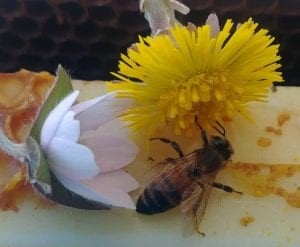How the Honey Pot is Filled
By: Jackie Woodcock
Honey is the only food made by an insect that is eaten both by humans and the insect itself. Bears, badgers and other animals also eat honey and have long been raiding the winter stores of their winged friends to harvest this tasty treat.
Honey is a very stable food that naturally resists molds, fungi and other bacteria, allowing it to last for years without refrigeration. It is well known that honey is made by a colony of honey bees living in a nest or in a hive if kept by a beekeeper.
A typical bee hive will house about 60,000 bees, most of them workers, industriously making honey and the honeycombs in which the honey is stored. That’s a lot of honey bees, working very hard to produce honey for the colony. It takes about 556 foraging bees to visit 2 million flowers, just to make a pound of honey!
How they do it
The process of making honey starts with foraging worker honey bees – and flowers, of course. The male honey bees, (drones), do not forage for the hive, and neither does the queen. As the weather begins to warm, the bees begin foraging on flowers. Bees have to work very hard to make honey, with endless trips to flowers to collect nectar. To produce a pound of honey, foraging honey bees fly a whopping 55,000 miles and visit up to 100 flowers – per foraging trip.
They will usually collect the sweet nectar from flowers within a radius of around 4 miles, and this nectar will then be taken to the hive. This sugary liquid is extracted from flowers using a bee’s long, tube-shaped tongue and stored in its extra stomach, or “crop.” While sloshing around in the crop, the nectar mixes with enzymes, known as the “bee enzyme,” which transforms its chemical composition and pH, making it more suitable for long-term storage.
When a honeybee returns to the hive, it passes the nectar to another bee by regurgitating the liquid into the other bee’s mouth. This regurgitation process is repeated until the partially digested nectar is finally considered honey. This is then dropped into wax cells, called honeycomb. These are hexagonal shaped cells the bees make out of beeswax, and they act just like storage jars, made of wax.
Once in the comb, nectar is still a viscous liquid — nothing like the thick honey you use at the breakfast table. To get all that extra water out of their honey, bees set to work fanning the honeycomb with their wings in an effort to speed up the process of evaporation. After some time, the water content is reduced to around 17 percent. When most of the water has evaporated from the honeycomb, the bee seals the comb with a secretion of liquid from its abdomen, which eventually hardens into beeswax. Away from air and water, honey can be stored indefinitely, providing bees with the perfect food source for cold winter months.
The toll of making honey on their lives lies in the hard work from honey bees, especially during spring and summer. It takes about 556 foraging bees to visit 2 million flowers, just to make a pound of honey. Honey bee workers born and active during this foraging time will live for around 6 or 7 weeks, whereas those born in autumn when there are honey stores may live 4 to 6 months.
________________________________________________________________________________










